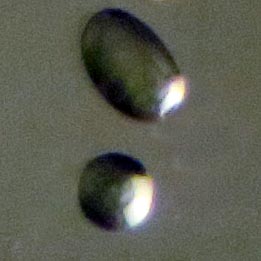


While large meteorites are extremely rare, micrometeorites are so common you probably walk on hundreds of them every day. They fall out of the sky in a constant rain that would quickly bury us, if they weren't so small you need a microscope to see them. But their small size doesn't prevent collecting and looking at them from being an interesting hobby, and if needed, a great science project.
Most references state that one micrometeorite falls on a square meter every year across the entire Earth. Considering that there are 510 trillion square meters of surface area on the Earth, that's a lot of meteorites. They range from 50 micrometers in diameter up to 2 millimeters. Larger than that and they are considered full meteors. The easiest way to collect them is to place some strong magnets in a plastic bag and hang it in the outlet of the rain gutters of your house. As the rain washes them off the roof, the magnets capture them. They can even be gathered off the ground by running a magnet over the area when the rain water empties out. The problem with this technique is that it also collects a lot of iron oxide that occurs naturally in most soils. Which ever technique you use, after removing the fine black powder sticking to your magnet, all you need is a microscope to look for the micrometeorites you captured. Most of the material will be iron filings from construction, fly ash or soil born iron oxides, but spread your catch in a thin layer over a glass microscope slide and scan it at low power and you'll be amazed at how many you'll spot. The following image shows how common they can be:

The actual width of the area covered in this image is 1/8th inch.
The arrows point to eight micrometeorites. There are others I'm sure I missed. The micrometeorites are smooth spheres and in this image range from 0.002 to 0.060 inches in diameter. They're spherical because when they slam into the upper atmosphere they completely melt, whereupon surface tension pulls them into spheres.
Using a magnification of 40X is best for finding them and 100X for close observation. Higher than that and the limited depth of field available in most microscopes means so much of them will be out of focus that they won't be very interesting. The good news is that under a microscope, particularly a stereoscopic one, the detail that can be seen in much greater than these images portray.
If you're in the middle of a drought and desperate to hunt down some micrometeorites, you can use a hose to wash them down. Another option is to mount magnets on the end of a stick and slide it all over the roof to collect the micrometeorites directly. Only adults with a safety observer and using safe procedures should attempt either of these.
The following images show a few of the hundreds I've collected:
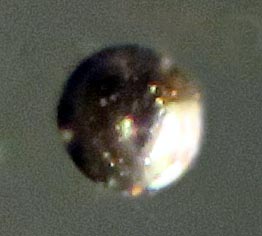
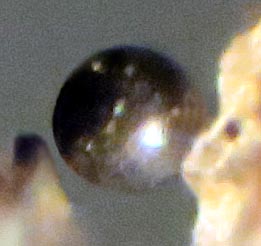

From left: the first micrometeorite is 0.004 inches in diameter. The next one is 0.005 and the last 0.002 inches. While all of these are iron based, the amount of iron varies so the color also varies. It's possble to have some that are almost transparent because most of the iron boiled away.
The 1 micrometeorite per square meter per year is for sizes around 0.050 inches. Larger ones are scarcer and smaller ones more abundant. There is very little information on the distribution frequency, but from my observations I've gotten the impression that the fall rate is closer to 2 per square meter per year for 0.005 inch objects and 4 or more for micrometeorites smaller than 0.003 inches across. I'm setting up a long-term experiment to measure the distribution frequency.
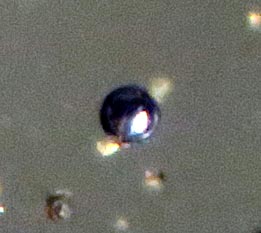
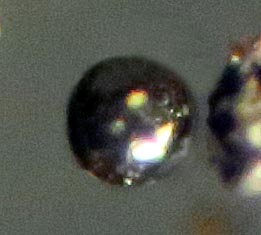
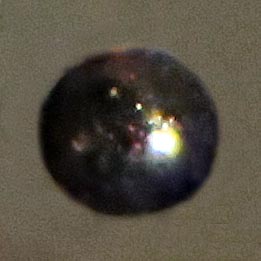
The first micrometeorite on the left is 0.003 inches in diameter. This is a very clean example. Most are perfectly smooth like this one. The surface imperfections seen on most of them are pieces of sand or other materials stuck to them. The micrometeorite on the far right is that largest I've found to date. It's 0.007 inches across.

This is a very interesting pair. The lower spherical one is typical, but the the upper elongated one is the only one like it I've found. Though to be truthful, I didn't find it. It was my granddaughter Abigail who did that. (Thanks, Abby!) I assume it got its football shape from spinning as it cooled, which stretched it out lengthwise.
As attractive as they may seem, there is a serious problem with finding true micrometeorites. Many natural processes, like volcano eruptions, and human activities, like burning coal, can put billions of microscopic melted particles into the air. These can rain down thousands of miles from their sources and mimic the appearance of micrometeorites. Distinguishing the real thing requires tools only available in a high-end laboratory. If you're collecting for micrometeorites for a science project, be sure to mention this.
Having acknowledged that issue, I believe, but can't prove, that iron based micrometeorites are common enough that they are easy to find and identify. Searching for them is a very satisfying hobby and I hope you'll give it a try.
If you'd prefer a live action version of this page, please click on the following link:
Return to my main page to browse 60 other subjects